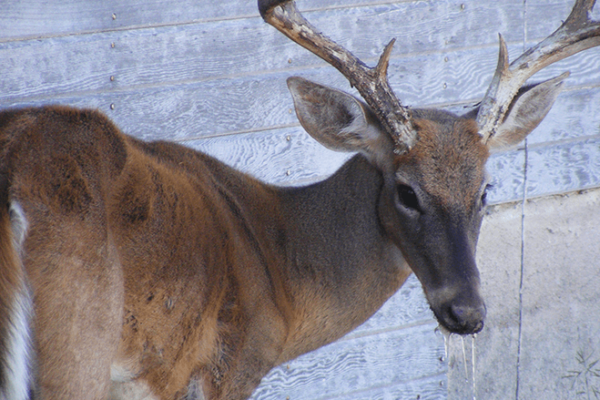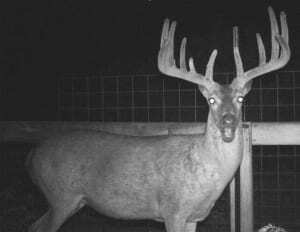By Drs. James C. Kroll and Donald Davis
It seems the entire “Twitterverse” is about to melt down over recent media reports that Chronic Wasting Disease (CWD) is on the verge of not only wiping out the entire whitetail population of North America, but human existence itself. Everyone seems to have an “informed” opinion about the seriousness of CWD, which has muddied the waters so much, we decided it’s time to clear up at least one of the misconceptions—the potential impact on humans.
First of all, the term “zombie” is anything but descriptive of the effects CWD has on deer. The dictionary defines zombie to be “a corpse said to be revived by witchcraft, especially in certain African and Caribbean religions.” Obviously, this does not apply to CWD, but it does make headlines that grab public attention. We traced the moniker, believe it or not, back to People for the Ethical Treatment of Animals (PETA) and the Humane Society of the United States (HSUS): not exactly friends of deer hunting. Unfortunately, the people who have encouraged (or not discouraged) use of the term “zombie” are part of the professional deer management and hunting community—creating a weird alliance between pro- and anti-hunting forces. To show you how pervasive the term has become, all you have to do is Google “zombie deer,” and before you even type in “deer,” you’ll get the term.
Even the usually hunting friendly Fox News posted a piece in which an archery store owner asserts that hunters may not take to the field this season, and features an interview with a Mississippi State University wildlife professor, who implies that carrying your deer home from another state is spreading CWD. All while these interviews are going on, the background video shows penned bucks with their antlers cut off, implying a link between CWD and deer farming. CWD has been reported in states that do not allow deer farming, and there never has been a link to privately owned deer. USDA data clearly show about twice as many CWD positive deer reported in the wild than for captive deer. We have asserted for some time CWD is only a problem if one of two situations arise: significant population declines in deer herds from CWD, and/or it can be tied to human health. It is the latter that has stirred up recent media coverage, and that is what we want to clear up in this column.
CWD has been on the radar since the late 1960s, when the late Elizabeth Williams first noticed it among mule deer in the Colorado State research pens. Talking with Dr. Kroll in the early 1980s, she remarked that she considered it a “condition,” rather than a disease. The condition was not of much interest to hunters until it showed up in 2002 in southwestern Wisconsin. TTHA has well-documented all the failed attempts by the Wisconsin DNR to “eradicate” the condition from their state. Yet, CWD remained off the radar of the mainstream media until this year.
The “hubbub” arose from statements made by Dr. Michael Osterholm before the Minnesota legislature: “It is my best professional judgment based on my public health experience and the risk of BSE (bovine spongiform encephalopathy) transmission to humans in the 1980s and 1990s and my extensive review and evaluation of laboratory research studies … that it is probable that human cases of CWD associated with the consumption of contaminated meat will be documented in the years ahead. It is possible that number of human cases will be substantial and will not be isolated events.”
Dr. Pete Larsen, assistant professor at the University of Minnesota College of Veterinary Medicine, also told the Minnesota legislature about as research project “…where a CWD-exposed rock was placed in a cage with hamsters — and they became infected.”
He added, “If I were to model contamination, the closest thing I can think of is it would be similar to modeling radioactive material,” Larsen said. He went on to curiously point out that very little is actually known about CWD, and elementary questions such as: What is an infective dose? And, where do deer actually contract it? It is very interesting that two “scientists,” warning of calamity, then state that little is actually known. That was Feb. 7, 2019. The following day, it was announced that a team of researchers including Dr. Larsen, sought funding ($1.8 million) to develop a rapid diagnostic test for CWD.
Pretty scary stuff offered up by these scientists, but there is one very sticky complication. There is not a shred of peer-reviewed, scientific evidence to support anything they said. The Twin Cities Pioneer Press, in reporting these comments, noted that “More than a year ago, Canadian researchers publicly presented initial findings that some primates — macaque monkeys — in a laboratory were fed CWD-infected meat and developed neurological disorders. The results have yet to be published in a peer-reviewed journal, but the findings sparked enough concern in Canada for the nation’s food safety agency to issue an advisory.”
However, there is peer-reviewed, scientific evidence to the contrary. We, with Drs. Kenneth Waldrup and Greg Stewart, co-authoring, discuss evidence for human risk concerns in our paper, “Current Scientific Knowledge About CWD” (https://texasdeerassociation.com/current-scientific-knowledge-about-cwd/). We point out that results from this unpublished study have not been corroborated by published studies. A National Institutes of Health study, published in 2018 in the Journal of Virology reported, “…14 macaques were cerebrally and orally exposed to brain matter from CWD-infected deer and elk, and then monitored for up to 13 years.” And noted, “…no clinical, pathological or biochemical evidence suggesting that CWD was transmitted” to the macaques. We further report, “In fact, current research from Colorado confirms that the incidence of Creutzfeldt-Jakob disease in humans living within 7 CWD endemic counties has not significantly increased between the years of 1970-2001 and no case of a human prion disease resulting from CWD exposure has ever been documented (McWhinney et al., 2006).”
Research to date tends to support the existence of a “…natural ‘species barrier’ reducing human susceptibility to CWD and other prion diseases.” (Kurt, et al. 2015; J. Clinical Investigation 125(4): 1485-96.) And long-term studies in Colorado and Wisconsin have found no presence of prion disease, in spite of the millions of pounds of venison consumed in these states.
Is it possible for humans to someday contract CWD? Anything is possible, but it’s the probability that counts. The only TSE disease known to date to jump from one species to another naturally is so-called “mad cow” disease, more appropriately called BSE. A variation of this disease, dubbed variant Creutzfeldt-Jakob (vCJD) disease, has been reported to have killed about 230 people in Europe (and about 4 in the US) since 1996.
The average annual per capita beef consumption in 2009 was 176.2 pounds (“FAO’s Animal Production and Health Division: Meat & Meat Products,” fao.org. Retrieved 2017-07-12). Using an average European population during that time of 503,000,000, a total of 44,314,300 English tons of beef have been consumed since vCJD was discovered. The percentage of Europeans contracting vCJD reportedly from eating beef was approximately 0.000045 percent. All human life is precious, but we must point out that during that same time approximately 2,000 people died in home accidents.
The critical point is, when CWD showed up in Wisconsin in 2002, three national outdoor publications reported that three men had died eating venison. At the same time, agencies were warning hunters not to eat venison from “sick looking” deer; something no hunter would do anyway. As a consequence, Wisconsin lost about 12 percent of its hunters, and they never returned.
As the old saying goes, “Politics creates strange bedfellows.”




